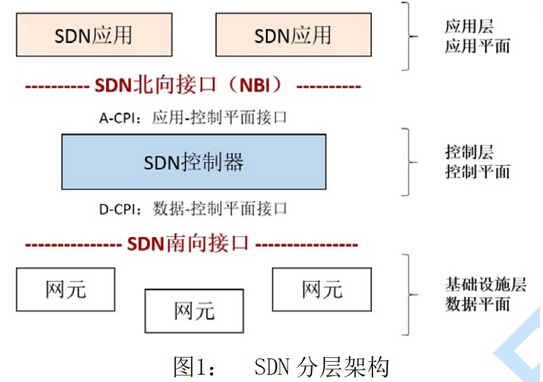In the field of communication, if you don't call SDN, you will be labeled as “outdatedâ€. From operators to equipment vendors to research institutes, no one is expressing their own opinions, which shows how SDN is hot today. However, this kind of fieryness makes SDN become confusing and unpredictable, and the first intuitive feeling for the industry is "chaos."
Indeed, as an epoch-making change in the history of communication, SDN has been over-represented by industry insiders in a long-awaited way. On the surface, great prosperity is a kind of chaos. Expansion, disillusionment, and finally towards rational maturity, become the most likely development trajectory of SDN.
In the three-tier architecture of SDN (infrastructure layer, control layer, application layer), it can be said that the control layer is the core, and it is precisely the most "chaotic". The status quo is far from the final maturity. The problems to be solved in the SDN control layer are both technical and non-technical.

Separate
The SDN Industry Development White Paper has made a relatively close summary of the development status of the SDN industry. It mentions that the SDN industry chain involves multiple links, and each link has different understandings of SDN for its own interests. What kind of technical route has not reached a consensus in the industry.
It is a good idea to integrate the superior resources of all parties to lead the development of technology through the open source model. In fact, the industry has adopted this idea. Unfortunately, although in the field of SDN/NFV, influential open source projects such as OpenDaylight, ONOS and OPNFV have been established, and some commercial deployment versions have been released. However, for potential users of SDN, in addition to companies with strong strengths such as Google and Facebook, and relatively simple requirements, companies can customize SDN solutions based on open source results according to their own needs. Most users usually rely on device providers. The solution to build the network. This raises a problem. Vendors tend to add some private content when developing solutions based on open source project results. How to allow different vendors to customize their own competitive solutions to mature SDN while maintaining the openness of the platform. A challenge.
Specific to the SDN controller, open source projects such as OpenDaylight and ONOS are basically based on the SDN controller platform. They all have their own different priorities and technical opinions. They all want to gain the right to speak and become the dominant player. The equipment vendors that adopt the open source architecture have added their own content to form a number of SDN controller solutions. Before the SDN collaboration problem still has no effective solution, it is impossible for the respective SDN controller solutions to have a clear understanding. market expectation.
Both hardware and software have obvious short boards
It seems that any change in the communications industry in the past is not as complicated as SDN/NFV, and there are so many challenges. If SDN is to mature, it must consider compatibility with the existing network, and also consider the hardware and software support of its own functions.
In terms of interface standardization, the SDN controller is still in a very early stage.
The standardization of northbound interfaces has just started, and has not yet formed industry-recognized standards. Under the SDN technology architecture, the northbound interface is the programming interface between the controller and the application, the management system, and the business orchestration system. The goal is to enable the business application to flexibly invoke the underlying network resources and capabilities. However, there are currently more than 20 different controllers on the market, and the northbound interfaces provided by each controller are not identical. This almost leads to the advantage of fast and flexible SDN technology in service deployment.
The southbound interface protocol is the interface between the controller and the underlying physical device. The current status is different from the northbound interface. Although the industry also proposes multiple control protocols including OpenFlow, PCEP, NETCONF, BGP, etc., the degree of standardization is higher. High, especially the OpenFlow protocol has been widely supported by the industry. The problem with the southbound interface protocol is that the OpenFlow protocol itself is constantly evolving rapidly, without a relatively stable version, and has not yet fully covered all known protocol types.
In addition to the north-south interface protocol problem, the software has many important problems in the coordination between the controller and the performance, reliability, scalability, stability, security and compatibility with the existing network of the open source system.
In terms of hardware, although Intel, Broadcom and other international top chip manufacturers have begun to force the field of SDN chips, the industry has not released a chip that fully complies with the OpenFlow protocol specification. The capacity of TCAM entries in the hardware switching chip becomes the control physics of SDN controllers. The main bottleneck in the number of switches. In addition, hardware switches and controllers from different vendors are still difficult to interoperate at this stage.
Although some relatively mature SDN controller solutions have been available for some specific application scenarios, SDN is still in the concept verification period. The industry chain can accelerate the standardization of SDN protocols and jointly build a more open SDN ecosystem. The SDN controller is mature, and SDN is likely to usher in scale development. When will it be ushered in that day? The industry expects at least 3-5 years to go.
UV Germicidal Light Air Purifier
Uv Air Purifier,Uvc Air Cleaner,Uv Germicidal Lamp,Air Duct Uv Light
Dongguan V1 Environmental Technology Co., Ltd. , https://www.v1airpurifier.com